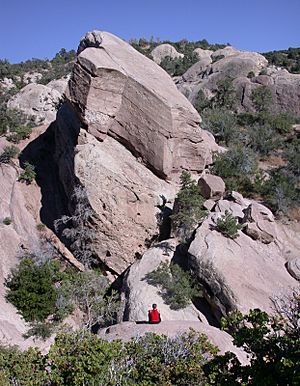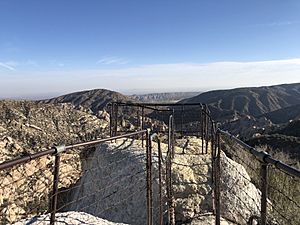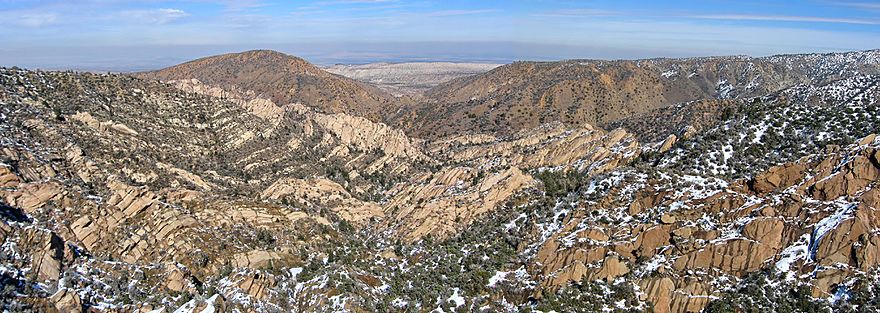Devil's Punchbowl (Angeles National Forest) facts for kids
The Devil's Punchbowl is an amazing place in Los Angeles County, California. It's known for its unique, tilted rock formations made of sandstone. You can find it on the northern side of the San Gabriel Mountains, high up at about 4,750 feet (about 1,448 meters) above sea level.
Contents
Exploring Devil's Punchbowl Park
The Devil's Punchbowl Natural Area is a special park managed by Los Angeles County. It's also part of the larger San Gabriel Mountains National Monument and the Angeles National Forest. You can find this park south of the Pearblossom Highway, close to the towns of Littlerock and Pearblossom.
The Devil's Punchbowl Nature Center used to be a hub for learning about the park's plants, animals, and incredible rock formations. It offered school programs, guided tours, and even telescope programs. Sadly, the Bobcat Fire in September 2020 caused a lot of damage, and the nature center was destroyed.
Awesome Trails to Explore
The trails in the park are perfect for seeing the amazing rock formations and learning about the San Andreas Fault. Some trails even connect to longer routes that go deep into the National Monument.
- The Devil's Punchbowl Loop Trail is a 1-mile (1.6 km) loop. It starts from where the Nature Center used to be and shows off important geological features.
- The Burkhart Trail is a longer 13.7-mile (22 km) route. It heads north from the park and is usually not too crowded.
- The Devil's Chair Hike is a 7.5-mile (12 km) round-trip adventure. It leads to a cool viewpoint called the Devil's Chair, which is a rock formation that looks like a giant seat.
The famous Pacific Crest Trail also goes through the park. It takes a special path here to help protect the mountain yellow-legged frog, an endangered animal.
The Amazing Geology of the Punchbowl
The main reason people visit the park is to see its incredible rock formations. These include the Punchbowl Formation, which formed during the Neogene period long ago. The Punchbowl itself is a deep canyon. It's a type of geological fold called a plunging syncline. Imagine the earth's layers being squeezed and folded into a giant V-shape!
The mountain peaks above the park reach about 8,000 feet (2,438 meters) high. The park's main area is at 4,740 feet (1,445 meters) above sea level. The Punchbowl Canyon is about 300 feet (91 meters) deep at its best viewing spot.
The strange, tilted rocks you see here were once flat layers of sedimentary rock. These layers formed when water deposited loose materials like sand and mud over millions of years. Later, powerful forces from the earth's crust squeezed and pushed these layers. This action, especially along the Punchbowl and Pinyon Faults and the famous San Andreas Fault, tilted them into the steep angles you see today. The Punchbowl Fault is south of the rocks, while the Pinyon and San Andreas Faults are to the north.
Plants and Trees: Life in the Punchbowl

As you drive into the park, you'll notice different types of plants. On the flat lands of the Antelope Valley, there aren't many large shrubs or trees. As the road climbs, you'll see Joshua trees and California junipers.
Inside the park, the Joshua trees disappear. They are replaced by Pinyon pine woodlands, with Chaparral shrubs growing underneath. Along the streambeds, like Punchbowl Creek, you'll find plants that need more water. These include cottonwoods and willows. Higher up in the San Gabriel Mountains, you'll find Coulter Pines and Yellow Pine forests. Even higher, White Firs stand tall against the sky on the mountain peaks.
The park was greatly impacted by the Bobcat Fire in 2020. It reopened to visitors in 2022, and you can now see new plant growth returning to the area.
Animals: Who Lives Here?
Many kinds of animals call the Devil's Punchbowl home. Most of them are nocturnal, meaning they are active at night, so you might not see them often. You might spot Gray foxes in the early mornings or at dusk. Occasionally, you might even see deer crossing the road.
Though rare, Bighorn sheep have been seen in the area. Smaller animals like chipmunks and California ground squirrels are active during the day. Many common birds live here, and even more species fly through the area at different times of the year.
The park's reptiles and amphibians are a mix of desert and mountain types. Some common local reptiles and amphibians used to be on display at the nature center. Rattlesnakes are also common, but they usually avoid people and are rarely seen. Insects and spiders are plentiful, especially in spring and summer. You can often spot them on flowers and shrubs throughout the park.
|





